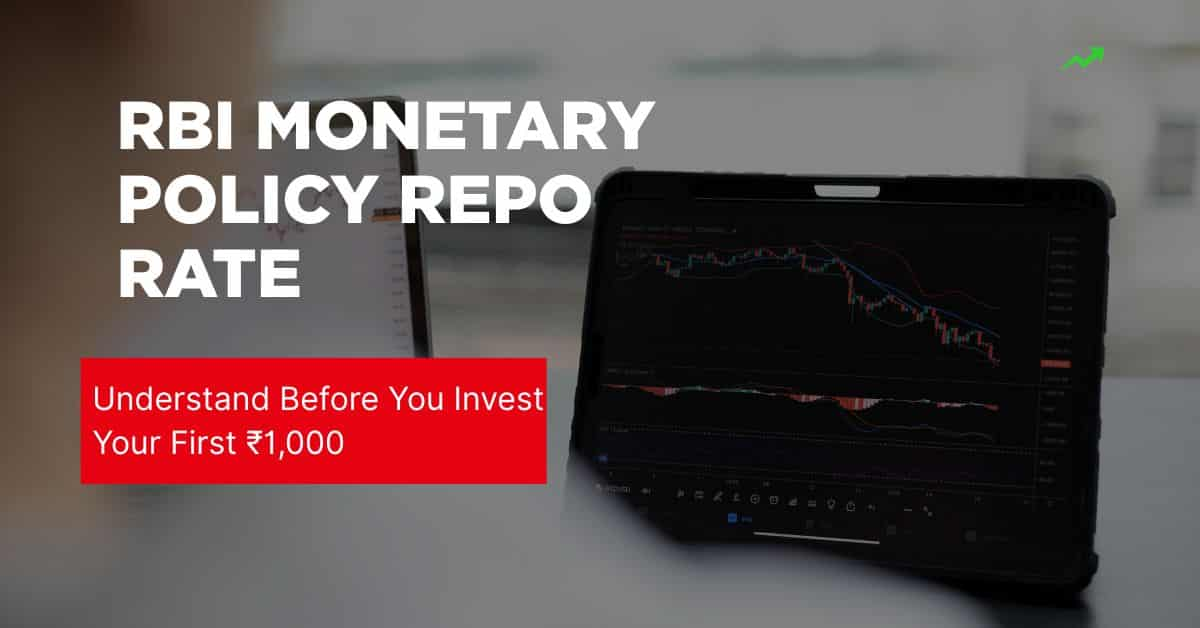RBI Monetary Policy Repo Rate: A term that frequently appears in financial news and conversations in India’s ever-changing personal finance and investment landscape is the “RBI repo rate.” Knowing the RBI’s monetary policy and its primary tool, the repo rate, can make all the difference, whether you’re a beginner investor experimenting with mutual funds, stocks, or even a basic fixed deposit. Imagine making an investment with your hard-earned ₹1,000 without knowing how changes in interest rates can impact your borrowing expenses or returns. The RBI repo rate, its function in monetary policy, and the importance of understanding these ideas before making your first investing move in 2025 are all covered in detail in this comprehensive guide.
The RBI has maintained the repo rate at 5.50% as of October 2025, indicating a neutral posture in the face of stabilising inflation and economic expansion. What does this signify for you, though? To assist you invest more wisely, let’s examine the fundamentals, workings, effects, and helpful tips in detail.
What is the Reserve Bank of India?
Established in 1935 under the Reserve Bank of India Act, 1934, the Reserve Bank of India (RBI) serves as the nation’s central bank. By overseeing banks, managing currency, and containing inflation, it protects India’s financial system. By establishing regulations that affect the flow of money, the RBI ensures fair play in the economy, much like the referee in a cricket match.

The RBI’s main goals are as follows:
- Preserving price stability (controlling inflation).
- Encouraging economic expansion.
- Preserving financial stability.
- Keeping track of foreign exchange reserves.
Monetary policy, which directly affects interest rates, liquidity, and eventually your investments, is one of its most effective instruments for achieving these objectives.
Comprehending the Monetary Policy of the RBI
The methods and measures used by the RBI to affect the money supply, interest rates, and availability of credit in the economy are referred to as monetary policy. It’s similar to regulating a car’s throttle to regulate speed; intense braking (strict policy) may result in a slowdown (recession), while excessive acceleration (loose money) may cause overheating (inflation).
Every two months, the Monetary Policy Committee (MPC), a six-member group comprising both RBI officials and outside experts, makes the RBI’s monetary policy announcements. Before voting on policy changes, the MPC considers important economic data such as GDP growth, unemployment, inflation (as determined by the CPI), and global variables.
Important elements of the RBI’s monetary policy consist of:
- Repo Rate: The rate at which banks borrow money from the RBI is known as the repo rate; more on this below.
- Reserve Repo Rate: The rate at which the RBI borrows money from banks is known as the reverse repo rate.
- Cash Reserve Ratio (CRR): The proportion of deposits that banks are required to maintain with the RBI.
- Statutory Liquidity Ratio (SLR): The percentage of deposits that banks invest in government securities is known as the Statutory Liquidity Ratio, or SLR.
- Policy Stance: Phrases such as “neutral,” “accommodative” (growth-supporting), and “calibrated tightening” denote policy stances.
After many rate cuts earlier in the year, the RBI’s focus has moved to balancing growth and inflation in 2025 as India’s economy recovers from global concerns.
What is the rate of repos? A Basic Justification
The “repurchase agreement rate,” or repo rate, is the interest rate at which commercial banks sell government assets to the RBI with the intention of eventually repurchasing them. It is essentially a collateralised loan from the RBI to banks.
Why is this important? Banks look to the RBI for funding when they need to provide consumers with credit, such as home loans or business credit. Banks can borrow money more cheaply when the repo rate is lower, which frequently results in lower interest rates for consumers. On the other hand, a higher repo rate lowers inflation and consumption by raising borrowing costs.
The Operation of the Repo Rate Mechanism
- Banks Borrow from RBI: In the event of a liquidity shortage, banks sell securities to RBI at the repo rate and repurchase them the following day or shortly thereafter.
- Market Signal: Variations in the repo rate convey the RBI’s economic outlook. A raise deters borrowing and investment, whereas a cut promotes it.
- Transmission to Economy: In response to changes in the repo, banks modify their lending rates (such as the base rate or MCLR), which has an impact on everything from deposit returns to EMIs.
Banks may lower home loan rates from 8.5% to 7.5%, for example, if the repo rate falls from 6% to 5%. This would make it simpler for you to invest in real estate funds or buy your ideal property.
The Historical Development of the RBI Repo Rate
Economic cycles are reflected in the notable swings in the repo rate over time. It peaked at 9% in 2011 to fight excessive inflation following the global financial crisis of 2008. It was cut to a record low of 4% in 2020–2021 to spur growth during the COVID-19 epidemic.
Just in 2025:
- 6.50% at the beginning of the year.
- Reduced by 50 basis points in June after being lowered by 100 basis points (1%) in the first half.
- According to the most recent MPC ruling on October 1, 2025, it remained constant at 5.50% in the August and October meetings.
Moderate inflation (around 5% CPI) and strong GDP growth (7-8%) anticipated for FY26 are the reasons for this dovish pause. If global uncertainties abate, investors should keep an eye on future meetings for possible more cuts.
The Impact of the Repo Rate on the Indian Economy
The repo rate is more than just a figure; it has an impact on many different industries:
- Control of Inflation: By reducing the money supply, higher rates prevent demand-pull inflation. When inflation reached 7-8% in 2022–2023, the RBI rapidly raised rates.
- Economic Growth: Lower rates encourage investment, expenditure, and the development of jobs. Rate cuts helped India recover from the pandemic.
- Currency Stability: The value of the rupee is affected by changes in exchange rates. Higher rates encourage foreign investment, which makes the INR stronger relative to the USD.
- Sectoral Impacts: A higher rupee may hurt exporters, while cheap rates help manufacturing and services.
To put it briefly, the repo rate aids RBI in balancing stability and growth.
The Repo Rate’s Effect on Your Investments
Think about how changes in repo rates can affect your portfolio before investing your initial ₹1,000. This is a summary:

1. Savings and fixed deposit accounts
- Low Repo Rate: Banks give deposits a reduced interest rate. Your FD returns could decrease from 7% to 6% if rates decrease, which would reduce real returns after inflation.
- High Repo Rate: Safe investments are more alluring when deposit rates are higher. Perfect for novices who are risk cautious.
- Advice: When hiking, lock in high-rate FDs. To establish habits, begin with a savings account or short-term FD for ₹1,000.
2. The stock market
- Rate cuts: Lower lending costs increase business earnings, which raises stock values. Industries that prosper include banking, real estate, and automobiles.
- Rate hikes: Rate hikes raise the cost of borrowing money and may cause market corrections. FMCG and pharmaceutical defensive stocks do well.
- For example, rate reductions in early 2025 drove the Nifty’s surge above 25,000. Watch for hints on benchmarks such as the Sensex.
3. Debt funds and bonds
- Falling Rates: Debt mutual funds gain from rising bond prices, which have an inverse connection with yields.
- Rising Rates: Short-term losses result from a drop in bond values.
- Suggestion: To reduce volatility, choose short-duration funds for modest investments.
4. EMIs and loans
- Low repo rates translate into affordable EMIs if you’re borrowing money (for example, an education loan). But borrowed funds for investing? Risky: understanding the cycle before.
5. Real estate and gold
- Low interest rates reduce the attraction of gold but increase real estate through more affordable mortgages.
- Gold is preferred as an inflation hedge at high rates.
For balanced exposure, spread your ₹1,000 over several different investments, such as ₹200 in gold through SGBs, ₹300 in a debt fund, and ₹500 in an ETF for blue-chip stocks.
The Importance of Knowing the Repo Rate Before Investing ₹1,000
It’s like driving while blindfolded when you invest without expertise. Market mood, returns, and risks are all impacted by the repo rate. A rate shift could eliminate gains or provide chances in the uncertain environment of 2025, which includes global events such as geopolitical conflicts and US Fed policies.
For beginners:
- Keep Up to Date: Use Moneycontrol applications, official RBI Twitter, or RBI announcements.
- Start Small: Learn how to use mutual fund SIPs with ₹1,000.
- Risk Control: Make investments consistent with the policy position—conservative during tightening, aggressive during accommodating periods.
- Common pitfalls: Include chasing high-risk options at rate highs or ignoring inflation (real returns matter).
Knowing the repo rate gives you the ability to make wise choices, which could help you expand your nest egg from that ₹1,000.
Frequently Asked Questions (FAQs)
As of October 2025, what is the RBI repo rate?
After the October 2025 Monetary Policy Committee meeting, the RBI adopted a neutral posture to balance inflation and growth by keeping the repo rate at 5.50%.
How frequently does the RBI assess the repo rate and make announcements about changes?
At its twice-monthly meetings, the RBI’s Monetary Policy Committee reviews the state of the economy and makes policy announcements, including possible adjustments to the repo rate.
What distinguishes reverse repo rate from repo rate?
The interest rate at which banks borrow money from the RBI is known as the repo rate, while the rate at which the RBI borrows money from banks is known as the reverse repo rate. The latter is usually set lower to control liquidity.
What impact does a change in the repo rate have on the EMIs for home loans?
A drop in the repo rate frequently results in banks lowering their lending rates, which lowers your home loan EMIs and lowers borrowing costs. On the other hand, a rise may result in higher EMIs.
When the RBI lowers the repo rate, should I buy stocks?
By reducing the cost of borrowing for businesses, repo rate reductions typically support the stock market by increasing profits and share prices. But always keep your risk tolerance, market conditions, and diversification in mind.
When the repo rate is raised, what happens to returns on fixed deposits?
Banks usually raise fixed deposit interest rates during a repo rate hike in order to draw in more capital, giving savers larger returns and making FDs a more alluring choice for conservative investors.
What effect does the repo rate have on Indian inflation?
By increasing the cost of borrowing and decreasing the money supply and spending, a higher repo rate aids in the management of inflation. If a lower rate causes the economy to heat up too much, inflation may be fuelled.
Can the Indian rupee’s value be impacted by the repo rate?
Indeed, while lower rates may devalue the rupee by promoting capital outflows, higher repo rates can boost it by drawing in foreign investors looking for higher yields.
Conclusion
The foundation of India’s financial system is the RBI’s monetary policy and repo rate. The forecast is stable with the current rate at 5.50% as of October 2025, but caution is necessary. This information gives you the ability to confidently handle changes in the economy, whether you’re investing in stocks, bonds, or savings.
Keep in mind that investing is a journey rather than a race. Diversify, get advice from a financial professional, and never stop learning. Understanding the repo rate and making wise investments could lead to financial freedom with your first ₹1,000!
How to Invest Small Amounts of Money in India – Even ₹500 Can Grow Big!
Top 5 Long-Term Investment Strategies for Young Adults in India
Tips on Stock Market for Safe and Smart Long-Term Investing!

I’m Rashid Ali, a personal finance blogger and content creator at SavingSecret.in, helping young adults in India master saving, investing, and tax planning. I simplify money topics like budgeting, IPO updates, and stock market tips to make finance easy and actionable. Follow me for smart money moves that actually work!
